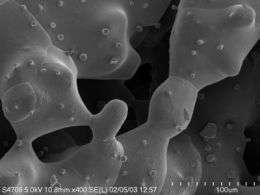Avalanches -- triggered from the valley

Everybody knows that skiers swishing down steep slopes can cause extensive slab avalanches. But there is a less well known phenomenon: A person skiing a gentle slope in the valley triggers a slab avalanche on a steeper slope, sometimes several hundred meters further uphill. This scenario doesn't seem to make sense – yet it claims human lives year after year.
But what exactly happens when an avalanche is remotely triggered? "In a slab avalanche, the upper layer of snow slides down into the valley. For that to be able to happen, it first has to become detached from the layer beneath it," says Prof. Dr. Peter Gumbsch, director of the Fraunhofer Institute for Mechanics of Materials IWM in Freiburg.
The view commonly held until now assumes that the layers of snow are separated by shear cracks – the upper layer shifts within a limited area. If the two layers of snow were two hands placed palm to palm, a shear crack would be equivalent to rubbing one hand against the other. The layers of snow can only shift if the slope is steep enough. Shear cracks may be a satisfactory explanation for the breakaway of snow slabs in steep terrain. But how can they be triggered from a distance?
Gumbsch and his colleagues Michael Zaiser and Joachim Heierli at the University of Edinburgh, Scotland, have developed a physical model that explains this phenomenon. "The boundary layer that connects the upper and lower layers of snow is made of ice crystals with fairly large interstices," explains Heierli. The pressure exerted by a skier can cause the ice crystals to break, separate from one another and slip into the interstices – the layer collapses. The layer on top of it subsides. This mass collapse, which can be described as an anti-crack, releases energy that has not previously been taken into account. This energy enables the crack to propagate. To return to our previous analogy, the anti-crack would be like pressing the two hands together.
Experiments carried out by Canadian researchers at the University of Calgary confirm the theory: Whether the slope is gentle or steep, it is equally difficult to trigger the collapse. Once it has started, it propagates as an anti-crack. It can move up or down the mountain and grow to a length of several hundred meters within a few seconds: The layers of snow lose their cohesion. Only the forces of friction can then prevent the snow from slipping. If these are insufficient, the upper layer slides off and a slab avalanche begins.
Source: Fraunhofer-Gesellschaft





















